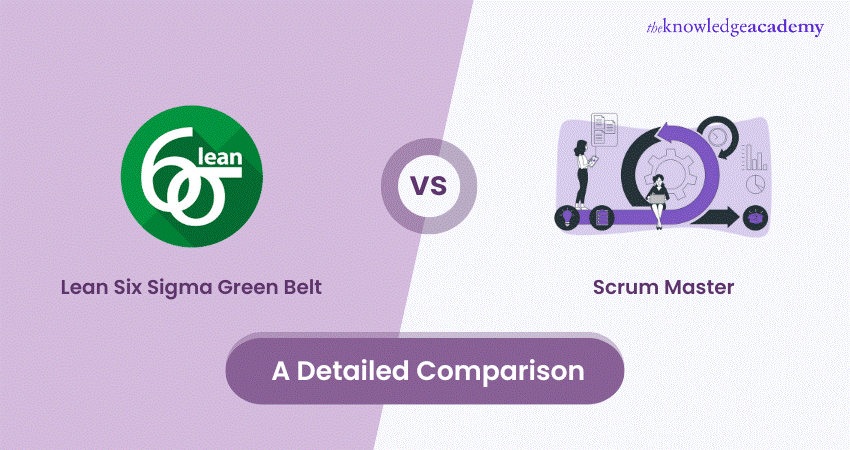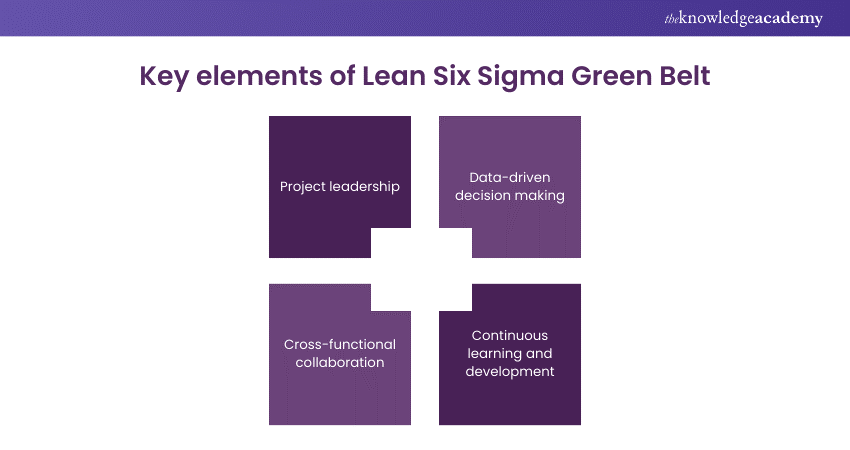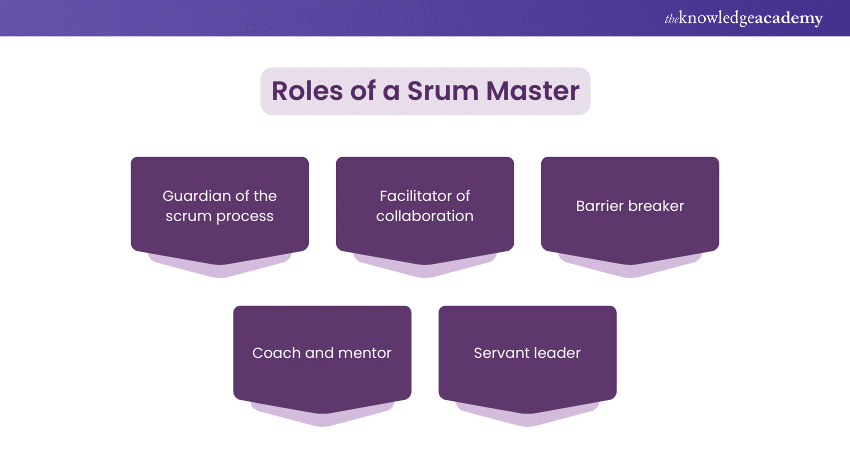We may not have the course you’re looking for. If you enquire or give us a call on +44 1344 203 999 and speak to our training experts, we may still be able to help with your training requirements.
Training Outcomes Within Your Budget!
We ensure quality, budget-alignment, and timely delivery by our expert instructors.

In this challenging and competitive business environment, the enterprises continuously look for innovative solutions that increase efficiency, decrease costs, and enable the customers to receive value rapidly. Lean Six Sigma and Scrum are two methodologies which have spread widely to various industries to these objectives. All methodologies have their special ways of meeting the needs of effective project management and process improvement. This article's aim is to deep dive into Lean Six Sigma Green Belt and Scrum Master professionals' roles. This analysis will compare Lean Six Sigma Green Belt vs Scrum Master and help you choose the best option for your organisation.
Table of Contents
1) What is Lean Six Sigma Green Belt?
2) Who is Scrum Master?
3) Difference between Lean Six Sigma vs Scrum
4) Conclusion
What is Lean Six Sigma Green Belt?

Lean Six Sigma is a very effective tool that combines six sigma and lean manufacturing concepts to eliminate any kind of waste, defects and achieve process improvement perfection. The Lean Six Sigma framework has different levels within it which are followed by the professionals. These include the Green Belt, Black Belt, and the Master Black Belt, each of them representing a different level of expertise and responsibilities.
An individual armed with the fundamental concepts of Lean Six Sigma and with the capability of leading small improvement initiatives within the organisation is as the Lean Six Sigma Green Belt. Green Belts function as the direct subordinates of Black Belts or Master Black Belts and are responsible for the execution of process improvement initiatives which take place in their assigned areas/departments.
The key responsibilities of Lean Six Sigma Green Belts are as follows:
1) Project leadership: Green Belts cause an enhancement in the projects through mobilising the resources, seeing to the objectives, and establishing the project plans in the organisation. By applying their analytical abilities and subject matter understanding, they bring teams towards the realisation of quantifiable gains in the operational performance.
2) Data-Driven decision making: Data acts as a cornerstone of Lean Six Sigma Methodology and Green Belts have adeptness in subskills such as statistical tools and analysis techniques which help to derive meaningful information from data. They create the KPIs (key performance indicators) and performance metrics to monitor development and assess results of advancement efforts.
3) Cross-Functional collaboration: Green Belts are engaged in active communication and collaboration with the departments and various stakeholders, including other smart workers. This allows a culture of teamwork and knowledge sharing to prevail. Such entities conduct workshops, brainstorming sessions and cross-function surveys to come up with solutions to complex challenges and work as a team.
4) Continuous learning and development: Lean Six Sigma is a journey of continuous improvement, and the Green Belts are dedicated to the development of their knowledge and skills through on-the-job training and professional development into a plunge. They keep tracking industry standards, upcoming trends, and productivity improvements to remain effective in their job roles.
Who is Scrum Master?

Scrum is a framework using Agile approach to managing projects, especially in software field. Its main points are incremental development, joint effort, and ability to respond to changing needs. At the core of Scrum is the Scrum Team, consisting of three primary roles: the Product Owner, the Development Team, and the Scrum Master.
The Scrum Master is a servant-leader with a responsibility of facilitating the Scrum Team to perform according to the Scrum framework and maintain its principles and practices. Unlike typical project managers, Scrum Masters give a greater attention to stand on facilitation, removing obstacles, and supporting self-organisation within the team.
The key responsibilities of Scrum Master is as follows:
1) Guardian of the scrum process: The Scrum Master is a keeper of the Scrum Framework, ideologist, and custodian of the Scrum principles, practices, and meetings. They do this through creating an atmosphere where the Scrum Team is at its best and lead them through the phases of planning, execution, review and reflection.
2) Facilitator of collaboration: Agile methods are based on cooperation, and Scrum Master - is the key role in organising teamwork, maintaining transparency, open communication, and trust within the group. They conduct ceremonies like Sprint Planning, Daily Scrums, Sprint Review, and Sprint Retrospective to enable attendant discussions and gracefully reconcile conflicts.
3) Barrier breaker: Despite the hurdles and challenges of any work that the Scrum Master might face, he/she tries to eliminate any obstacles that prevent it from advancing. Their role is fourfold, in problem solving, conflict resolution, and external dependencies mitigation to let the team remain focused and unhindered in value creation.
4) Coach and mentor: The Scrum Master is a personification of the mind, inspiring each team member to evolve toward mastering Agile philosophies and methods. They help, give feedback, and support people as a way of transferring the skill of self-organisation, accountability while revealing ownership of their tasks to them.
5) Servant leader: So above everything else, the Scrum Master personifies the servant leadership where their sole aim is service above self. They practice what they preach — they showcase humility, empathy and the determination to help others. Rather than wielding power, they are intent on empowering the team to discover its virtuosity as a well-integrated whole unit.
Difference between Lean Six Sigma vs Scrum
In the search of operational excellence and continuous improvement, organisations often find themselves at a crossroads, deliberating over which methodology to adopt: examples of Agile Methodologiessuch as Lean Six Sigma and Scrum. Although both approaches belong to the same field of studying consequences and increasing efficiency, they differ in their methodology, theories, and applications areas. Let us move into the comparison of the key distinctions between lean six sigma and scrum to know about what each of them possesses and how relevant they can be in different situations.
|
Aspect |
Lean Six Sigma |
Scrum |
|
Methodology and focus |
Concentrates on efficiency and waste reduction via structured processes and data-driven decisions. |
Revolves around iterative development and adaptive planning, prioritising flexibility and responsiveness. |
|
Project scope and scale |
Ideal for large-scale, complex projects with defined problems requiring statistical analysis. Often used in manufacturing and process improvement. |
Suited for projects with evolving requirements and a need for frequent adaptation, typically in software development and innovation. |
|
Roles and responsibilities |
Assigns specific roles like Black Belts, Green Belts, and Champions, each with distinct responsibilities in project leadership and implementation. |
Features cross-functional teams with dynamic roles including Scrum Master, Product Owner, and Development Team members, promoting collaboration and collective ownership. |
|
Problem-solving approaches |
Utilises DMAIC (Define, Measure, Analyse, Improve, Control) or DMADV (Define, Measure, Analyse, Design, Verify) methodologies for systematic issue resolution. |
Embraces empirical problem-solving through iterative cycles of inspection and adaptation, focusing on incremental value delivery and addressing emerging challenges. |
|
Timeframes |
Typically involves longer project timelines due to the rigorous data analysis and structured approach. |
Promotes shorter development cycles known as sprints, usually lasting 2-4 weeks, allowing for rapid iterations and frequent feedback. |
|
Customer involvement |
Customers may not be directly involved in the project, with solutions often driven by internal process optimisation. |
Encourages continuous customer involvement through feedback loops and product demonstrations, ensuring alignment with user needs and preferences. |
|
Change management |
Adopts a more formal change management process, focusing on minimising risks and ensuring smooth transitions. |
Embraces change as a natural part of the development process, with mechanisms in place to accommodate and even embrace change requests throughout the project lifecycle. |
|
Metrics and measurements |
Relies heavily on Key Performance Indicators (KPIs) and statistical metrics to measure process improvements and project success. |
Prioritises empirical data such as velocity, burndown charts, and product increments to measure progress and inform decision-making. |
|
Documentation |
Emphasises comprehensive documentation of processes, analyses, and outcomes to ensure traceability and replication. |
Values working software over comprehensive documentation, although necessary documentation is produced, with a preference for face-to-face communication and collaboration. |
Methodology and focus
Leveraging on the principles of Lean Manufacturing and Six Sigma, Lean Six Sigma ensures low level of waste, less variation, and an optimised processes to achieve a state of operational excellence. By introducing structured problem-solving approaches, like DMAIC (Define, Measure, Analyse, Improve, Control), it allows for identification of inefficiency’s sources and improves them accordingly.
Scrum becomes an Agile framework that focuses on iterative development, customer collaboration, and up to date changes in business needs. It is highly efficient for projects with proportional specifications that involve a smooth working environment. Scrum promotes timebound Sprints, that is iterations of work, during which a cross-functional team produces an increment of functioning software or a product.
Improve your organisational efficiency through our Six Sigma Green Belt Course!
Project Scope and scale
In many cases, the Lean Six Sigma method is used in large-scale improvement initiatives that are extremely analytical and require a lot of statistical tools. It can be leveraged for fine-tuning current operations or diagnosing and healing long-term company ailments. Lean Six Sigma projects oftentimes are cross-departmental or going through the whole business system for them to achieve a significant amount of improvement in efficiency and quality.
In contrast, Scrum is an appropriate choice when the projects are expected to have a high level of uncertainty or variable requirements. It Agilely supports cross-functional teams that are working on the deliverables that can be split into measurable units called Sprints. Scrum projects provide the value delivery to customers little by little so that they can be consulted and modifications to the work products can be made often.
Roles and responsibilities
The Lean Six Sigma structure differentiates contributors by their level, which is formed by Green Belts, Black Belts, and Master Black Belts. Each stage corresponds to the hierarchical level with its own process improvement projects. Additionally, Green Belts embody the basic principles of Lean Six Sigma through leading successful small-scale projects which lie under the mentoring and steering of the Black Belts and the Master Black Belts.
In Scrum, the roles are something you can't put your thumb on and are more fluid, with the Product Owner, the Development Team, and the Scrum Master as the main roles. A Product Owner is someone who speaks for the preferences of the interested parties and decides which work must be accomplished by the Development Team. The members of the Development Team are specialists teaming up to provide successive product increments that are operational. Scrum Master plays a role that we discussed before - a servant-leader whose responsibility is to make everyone work in teams, remove problems and keep everything in the Scrum.
Problem-solving approach
Lean Six Sigma is quite a useful tool which uses a structured problem-solving methodology like DMAIC or DMADV (Define, Measure, Analyse, Improve, Control or Define, Measure, Analyse, Design, Verify) to solve process problems and cause improvement. This approach emphasises validity and accountability and uses the results of ongoing monitoring to evaluate the improvement.
Scrum does this through the practice of empirical process control, where teams lean on the immediate judgment and monitoring of the team members in order to make informed decisions. It is based on the principle of openness, control, and the relevant modifications to deal with complexity and risk. Teams of scrum constantly redesign their methods in view of the stakeholders' experiences or in the context of the project's changes.
Conclusion
In conclusion, Lean Six Sigma Green Belt vs Scrum Master is not a direct comparison but are different and powerful tools for achieving operational excellence and customer satisfaction, however they use a combined toolbox for just that reason. On the other hand, Scrum is Agile which implies it uses iterative development and adjusting swiftly towards changing requirements.
It is a question of choosing the respective method as per the type of project, organisation’s culture and the projected outcome. Organisations which may enjoy a synergy from the combination of both methods can make a great benefit out of it by bringing together excellence and wholeness. Finally, in the face of a volatile business environment any business should develop a culture of continuous improvement, adaptability, and/or customer-centricity.
Improve your organisational efficiency through our Lean Six Sigma Yellow Belt Course
Frequently Asked Questions

The certification of Lean Six Sigma Green Belt, by and large, may be worthwhile for people who are willing to advance in their career within the industries that give more attention to initiatives of process improvement. It contributes to the community with valuable proficiency and magnifies the fact that the organisation has a high quality.

In a nutshell, it is impossible to nominate a particular approach as having provided better performance than the other. Scrum is well-suited for variable projects necessitating adapting and working together, but Six Sigma is good at data-driven decisions and optimising processes. Depending on the project's purpose, organisational culture and desirable outcomes, the choice is a matter of personal preference.

The Knowledge Academy takes global learning to new heights, offering over 30,000 online courses across 490+ locations in 220 countries. This expansive reach ensures accessibility and convenience for learners worldwide.
Alongside our diverse Online Course Catalogue, encompassing 17 major categories, we go the extra mile by providing a plethora of free educational Online Resources like News updates, Blogs, videos, webinars, and interview questions. Tailoring learning experiences further, professionals can maximise value with customisable Course Bundles of TKA.

The Knowledge Academy’s Knowledge Pass, a prepaid voucher, adds another layer of flexibility, allowing course bookings over a 12-month period. Join us on a journey where education knows no bounds.

The Knowledge Academy offers various Lean Six Sigma Certification Training, including Lean Six Sigma Green Belt Course, Lean Six Sigma Yellow Belt Course and Lean Six Sigma Black Belt Course. These courses cater to different skill levels, providing comprehensive insights into Six Sigma Belts.
Our Business Improvement Blogs covers a range of topics offering valuable resources, best practices, and industry insights. Whether you are a beginner or looking to advance your Business Improvement skills, The Knowledge Academy's diverse courses and informative blogs have you covered.
Upcoming Business Improvement Resources Batches & Dates
Date
 Lean Six Sigma Green Belt
Lean Six Sigma Green Belt
Mon 29th Apr 2024
Tue 7th May 2024
Mon 13th May 2024
Sat 18th May 2024, Sun 19th May 2024
Mon 20th May 2024
Tue 28th May 2024
Mon 3rd Jun 2024
Mon 10th Jun 2024
Mon 17th Jun 2024
Sat 22nd Jun 2024, Sun 23rd Jun 2024
Mon 24th Jun 2024
Mon 1st Jul 2024
Mon 8th Jul 2024
Mon 15th Jul 2024
Sat 20th Jul 2024, Sun 21st Jul 2024
Mon 22nd Jul 2024
Mon 29th Jul 2024
Mon 5th Aug 2024
Mon 12th Aug 2024
Sat 17th Aug 2024, Sun 18th Aug 2024
Mon 19th Aug 2024
Tue 27th Aug 2024
Mon 2nd Sep 2024
Mon 9th Sep 2024
Sat 14th Sep 2024, Sun 15th Sep 2024
Mon 16th Sep 2024
Mon 23rd Sep 2024
Mon 30th Sep 2024
Mon 7th Oct 2024
Sat 12th Oct 2024, Sun 13th Oct 2024
Mon 14th Oct 2024
Mon 21st Oct 2024
Mon 28th Oct 2024
Mon 4th Nov 2024
Sat 9th Nov 2024, Sun 10th Nov 2024
Mon 11th Nov 2024
Mon 18th Nov 2024
Mon 25th Nov 2024
Mon 2nd Dec 2024
Sat 7th Dec 2024, Sun 8th Dec 2024
Mon 9th Dec 2024
Mon 16th Dec 2024









 Top Rated Course
Top Rated Course



 If you wish to make any changes to your course, please
If you wish to make any changes to your course, please


